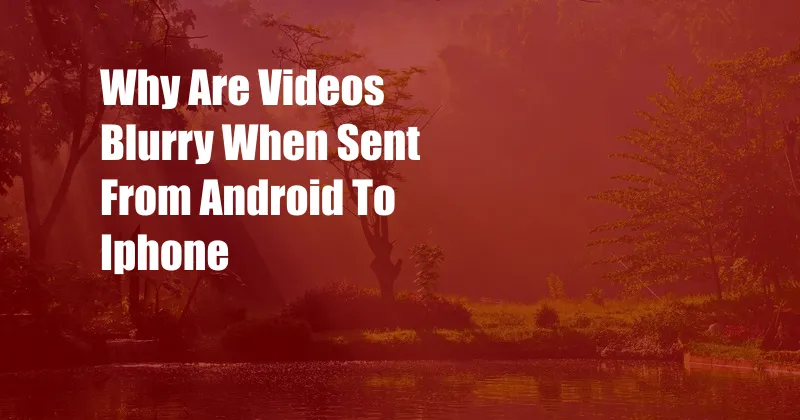
Why Are Videos Blurry When Sent from Android to iPhone?
It’s a common problem that arises when sharing videos between Android and iOS devices: videos tend to appear blurry or pixelated upon transfer. Why does this happen? Let’s delve into the technicalities behind this phenomenon and explore the potential solutions to maintain video quality during cross-platform sharing.
When sending a video from Android to iPhone, the video is essentially converted from one video format to another. This process involves recompression, which can lead to a loss of quality if not handled properly. Additionally, Android and iOS use different video codecs, which further contributes to the potential for quality degradation during conversion.
Compression and Transcoding
Compression
Video compression involves reducing the file size while preserving its visual quality as much as possible. Android and iOS use different video compression standards, with Android typically using H.264 (also known as MPEG-4 Part 10) and iPhone using HEVC (High-Efficiency Video Coding). HEVC is more efficient at compression than H.264, which means it can achieve smaller file sizes without sacrificing quality. However, when converting a video from H.264 to HEVC, there may be some loss of quality, especially in areas with high detail or rapid motion.
Transcoding
Transcoding is the process of converting a video from one format to another. When sending a video from Android to iPhone, the video may need to be transcoded to a format that is compatible with iOS. This process can also introduce quality loss, especially if the transcoding is not done carefully.
Tips for Maintaining Video Quality
Here are a few tips for maintaining video quality when sending videos from Android to iPhone:
- Use a high-quality video recording app. This will ensure that the original video is of good quality, which will give you more to work with when converting and compressing it.
- Choose the right video format. If you know that you will be sending the video to an iPhone, consider recording it in HEVC format. This will help to minimize quality loss during transcoding.
- Use a video converter that supports high-quality transcoding. There are many different video converters available, but not all of them are created equal. Some converters use low-quality transcoding algorithms that can introduce significant quality loss. Do some research to find a converter that uses high-quality algorithms and supports the formats you need.
FAQs
- Q: Why do videos look blurry when sent from Android to iPhone?
- A: Videos can look blurry when sent from Android to iPhone because of the different video compression standards and codecs used by the two platforms. When a video is converted from one format to another, there may be some loss of quality, especially in areas with high detail or rapid motion.
- Q: How can I improve the quality of videos sent from Android to iPhone?
- A: There are a few things you can do to improve the quality of videos sent from Android to iPhone. First, use a high-quality video recording app. Second, choose the right video format. Third, use a video converter that supports high-quality transcoding.
- Q: What are some of the best video converters for sending videos from Android to iPhone?
- A: Some of the best video converters for sending videos from Android to iPhone include HandBrake, FFmpeg, and VLC Media Player.
Conclusion
By understanding the reasons behind blurry videos when sent from Android to iPhone, you can take steps to maintain video quality during cross-platform sharing. By using a high-quality video recording app, choosing the right video format, and using a video converter that supports high-quality transcoding, you can ensure that your videos look their best on any device.
Are you interested in learning more about video compression, transcoding, and other video-related topics? Stay tuned for our future articles, where we will delve deeper into these fascinating aspects of the digital media world.